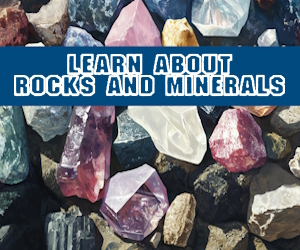A Brief summary of the mineral occurences and geology of high Val Varaita
English
Castellano
CatalĂ
A Brief summary of the mineral occurences and geology of high Val Varaita
Author: Marco Macchieraldo
Content by courtesy of : Marco Macchieraldo Minerals
Copyright 2003 by Marco Macchieraldo.
All photos by author and specimens from his personal collection unless otherwise noted.
Reproduction of text and photos prohibited without permission of author.
Acknowledgements
Special thanks for this article go to F.S. and F.M., Italian cristalliers. In the summer of 2002 they helped me find nice specimens and gave much knowledge about locating, and collecting fissure specimens. Without their help this paper would not have been possible.
NOTE. This page is photo intensive and can be slow to load. If some photo is not complete please reload the page.
INTRODUCTION
The Varaita valley is located in the north-west part of the province of Cuneo – Piemonte and is engraved in the east side, turned towards Italy, of the Cozie Alps. It’s located between Maira valley in the south side, and Po valley in the north side. It has almost rectilinear course from the outlet in plain, in the round of Saluzzo, until the village of Casteldelfino. Beyond it begins the territory of the high Varaita valley that is object of the present job. The territory of the high Varaita valley is relatively large and comprises along feature of the border with France in the north and in the west. Between the Punta Gastaldi, in the massif Monviso and the Monte Maniglia. From the village of Casteldelfino the main valley is divided in two arms: val Varaita of Chianale goes them towards the north-west furrowed from the mountain road of Colle dell’Agnello (closed to the traffic from October to june) and val Varaita of Bellino goes them towards the west. Both the arms are furrowed from wide cross-sectional walloons. From the administrative point of view, there aren’t zones comprised in natural parks on the Italian side while, on the French side, the zone to north of the Roc della Niera is comprised in the Regional Park of Queyras. The territory considered in this work and represented in the following photo, constitutes a rectangle of approximately 13 km. from the west to east and of 18 km. from north to south.
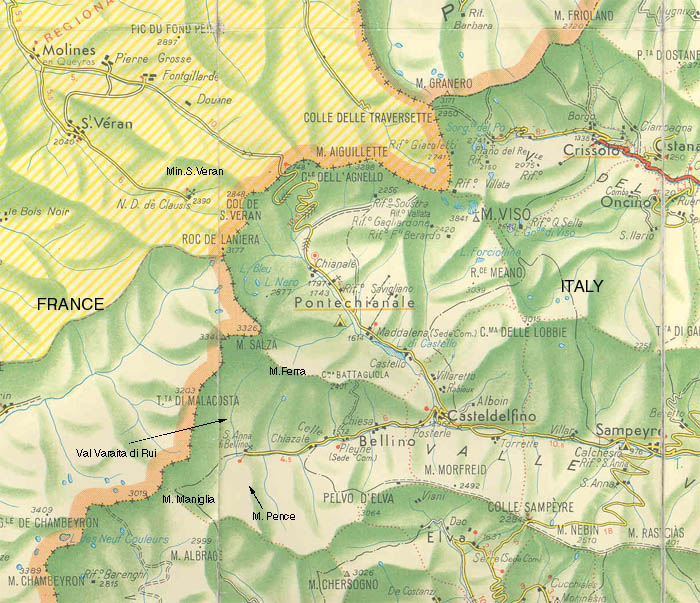
This territory is mainly occupied from elevated tips, many of them (about thirty) catches up or exceeds the 3000 meters of height on the seaÂ’s level. ItÂ’s a typical alpine territory that, for geographic and climatic characteristics, is accessible exclusively in the summery months. Probably also for these reasons, the zone was completely unknown, from the mineralogic point of view, until little years ago. The merit of the first findings must go to the work of two skillful reserchers, F.S. and F.M. that I personally know. They began the systematic exploration of these places in the second half of years eighty. Thanks to their researches, important discoveries have been made, some of which cover absolute interest and occupy a place of relief in the immense mineralogic alpine park. The work of these men is comparable to that one of the French 'cristalliers' of the Monte Bianco, (see my Monte Bianco article on this site) and we have to thank them, if the beautiful crystallizations of these mountains are now in our collections of alpine minerals. Fortunately their job (made of alarm clock at 4,00 A.M., 4-6 hours of march in climb, research work and collection in conditions that still can be very dangerous) continuous today with one admirable passion. In the last years other researchers discovered new sites, and probably others will follow in future. The vastness of the territory is, like already said, such to demand still many years because the mineralogical exploration can be considered complete.
GEOLOGIC NOTES
This zone is included in the piemontese geologic zone of the calcescists with green stone. The green stones are those strips of serpentino or prasinite with typical green-gray colour, that derive from the deepest parts of the oceanic crust of the sea ‘Tetide’ that existed in the Mesozoic (approximately 160 million years) between European sod and African one. In that time strong submarine volcanic eruptions happened, and bringed large basaltic lava-flows and gabbric and peridotitic intrusions. All was intercalated with big oceanic sediments’s deposits. Subsequently, in the Cenozoic age (approximately 40 million years ago), the African sod began a slow movement towards north that bringed up the closing of the Tetide sea and the formation of imposing mountain chains in the south of Europe. The oceanic crust endured intense methamorfism’s phenomena during the uplift and was transformed in serpentini, prasiniti and calcescists. During the final phase of the uplift the fissures that had been formed in the massive rock was crossed from hydrotermal fluids that bringed to the formation of the typical alpine minerals. The most interesting mineralogic area corresponds to the border zone that is extended between the Colle dell’Agnello and the Monte Maniglia and interests both the Italian and French sides. Towards south the outcrops of green stones go away from the border line and, following a direction north-south, reappear in the Monte Pence and, still more to south, in Val Maira near Acceglio. The mineralogic specimens of interest for collectors that can be found are those common to all the outcrops of green stones, with prevalence depending from the specific site, of one or other minerals. As general rule, it prevails albite, for frequency, beauty and extension of the crystallizations. As subordinate amount they recovered epidoto, hematite, calcite, quartz, amphiboles. This minerals can variously be associated creating specimens of remarkable aesthetic effect. Magnetite is rarer and garnet andradite in the var. melanite was exclusively found on the French side. Occasionally, pyrite and chalcopyrite in crystals immersed in the rockk or, more very rarely, in the fissures were observed. In a unique site the presence of anatase is famous in paragenesys with other species. The following descriptions of the zones of mineralogic interest follow an accidental order, topographical independently, from where they are located and from the minerals present and hardly comprise also a mine situated in French territory after the border Italy-France, the mine of S.Veran. The zone at north-west of the Colle dell’Agnello in which is comprised the val Varaita side of Monviso, has not, up to now, offered findings.
ZONE BETWEEN THE COLLE DELL'AGNELLO AND THE ROC DELLA NIERA.
This zone is famous for the presence of numerous crystallized fissures. TheyÂ’re usually of limited extension. ItÂ’s possible to remember the presence of calcite, in centimetric white crystals near the road that gous up to Colle dellÂ’Agnello. Discreet epidote crystals were found near the Colle S.Veran. They have dark green color, are prismatic and associated to extended crystallizations of white or colourless albite but have small dimensions. Others epidotes in crystals of light green color have been find on the French side of the Colle dellÂ’Agnello. Quartz in white crystals has been found on the Rocca Bianca. A small outcrop located in the pressed ones of the Colle dellÂ’Agnello arouses curiosity. Here an interesting paragenesis with the presence of the three modifications of titanium dioxide has been recovered with albite, quartz and titanite. ItÂ’s the only outcrop of this famous kind know till now in the territory of the Alpi Cozie comprised in the province of Cuneo. The most common mineral is the anatase. It is found in bipyramidal crystals, generally with submillimetric dimensions, with intense red color, very rare one in this mineral. Closely associated to the anataseis rutil, in fine acicular crystals of yellow color. Brookite is rare, in tabular crystals with brown color. Titanite is also found in small crystals with nice violet colour. The specimens from this site are particularly appreciable if they are observed through to the microscope.
ROC LA NIERA (3177 m.)
ItÂ’s considered one of the most interesting tips of Val Varaita. This is true from the landscaped point of view and itÂ’s also an important orographic node located on the crest of border Italy-France. ItÂ’s known as mountain of the three valleys because itÂ’s on the origin of the Val Varaita on the east side, on the origin of the Ubaye valley on the south-west side and on the origin of the Aigue Blanche valley on the north-east side. The tip of the pyramid is constituted of green stones.
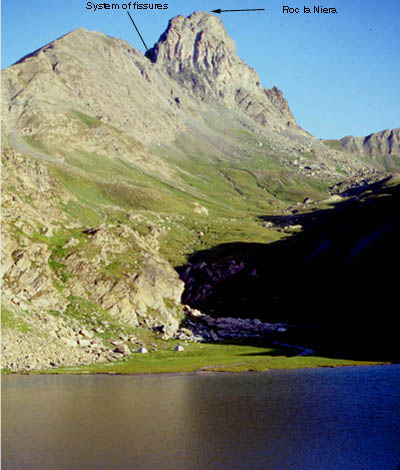
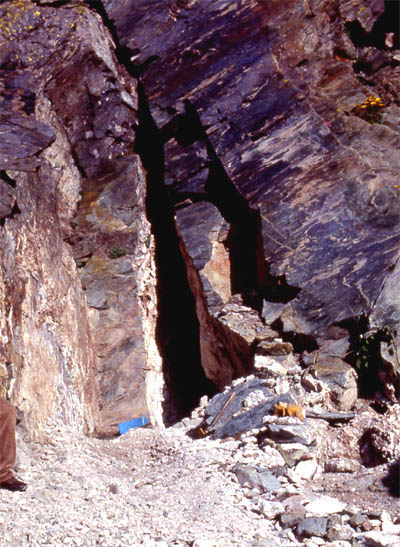
In 1985, near the border Italy-France, it has been discovered one of the most extraordinary system of crystallized fissures with albite and epidote of the Western Alps. This system of fixures (see the above photo on the right) had vertical course and were completely covered from extended albite crystallizations. They had in origin 1 meter of width, 3 meters of height and 2 meters of depth. Other smaller fissures were found nearly. From this site it has been extracted a considerable number of albite specimens in association with epidote. The specimens are considered exceptional for freshness, brightness, dimensions of crystals and extension of the crystallizations. In the collection of the Regional Museum of Natural Sciences of Torino, an exceptional albite with epidote druse is present. The sizes of it are 41x23 cm. !! It has been more times exposed for mineralogic shows. The albite is the most common mineral. XXs have classic shape, very rarely single, usually intersected between themselves. They have tabular habit, frequently twined with the albite’s law, have white or colourless colour, generally on massive albite matrix. Very common the polisintetic increases, and the dimensions of the groups of crystals can reach 5-6 cm. The epidote is the other mineral in this site as suborder regarding the albite. It is introduced in prismatic crystals with dark green color, often re-united in elegant groups between albite crystals, with remarkable aesthetic effect. The crystals can reach 3-4 cm. of length. Without collectionistic interest is the calcite, present in rare ugly crystals or massive. From veins in the serpentiniti on the French side, in the feature comprised between the Roc of the Niera and Col du Longet, interesting magnetite specimens in rombododecaedric crystals were found. They ‘re very brightly and can reach the sizes of 1 cm.. They ‘re in association with chlorite and andradite garnet var. melanite. Also the crystals of these minerals are rombododecaedric, brightly and the size can reach 5 mm.
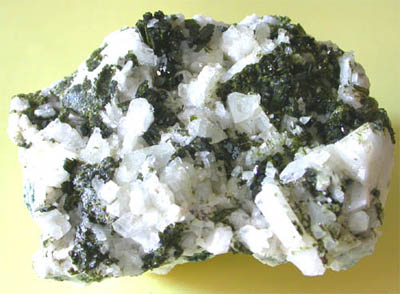
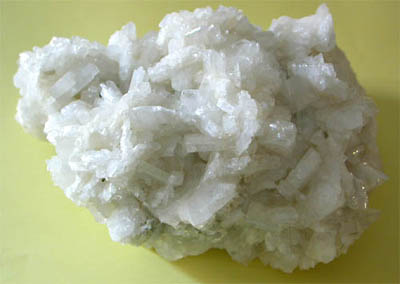
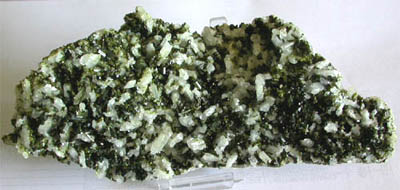
VAL VARAITA DI RUI
The hidden Val Varaita di Rui has great interest from the naturalistic and landscaped mineralogic point of view. It constitutes a lateral walloon directed towards north at the head of val Varaita di Bellino. Its skillful side is delimited from the watershed feature that constitutes the border Italy-France between the Monte Salza and the Monte Pelvo di Ciabrera. Several findings of minerals were made on both the sides of the chain on the border Italy-France.
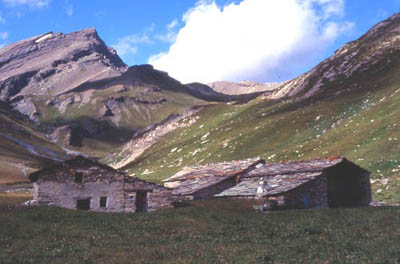
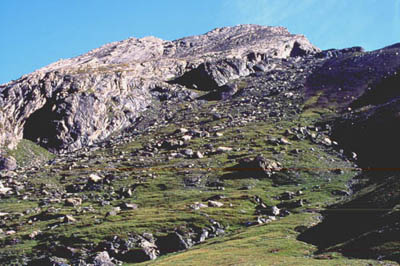
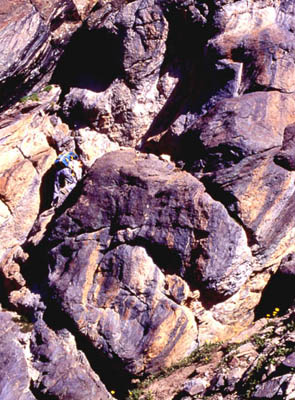
The most common mineral, also in these veins, is the albite. Between the associated minerals itÂ’s remarkable the hematite, the epidoto and the quartz. The albite covers wide fissures with crystals of classic habitus, single or twined with the albiteÂ’s law. The sizes of crystals are inferior to those found on the Roc della Niera and the polisintetic growth are less frequent. The colors go from the white to green for byssolite inclusions and the crystals are similar in the shape to those coming from the Monte Pence (see below). Between the minerals of this zone, hematite covers great interest. It was found in specimens of collectionistic interest in a system of fissures crystallized with albite on the Monte Salza (see the photo on the left). In this site hematite is introduced in lamellar crystals with typical disposition at ironÂ’s rose that can reach up 3-4 cm. of diameter. The crystals have black brilliant color. Some of them have to be exposed with acid because are immersed in massive calcite. They are offered with elegant shape on druses of white or green albite and create a beautiful aesthetic effect. TheyÂ’re considered the best ones you can find in this sector of Alps and comparable with the most famous specimens from Swiss sites like S.Gottardo or Cavradi.
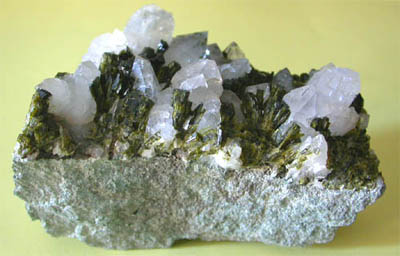
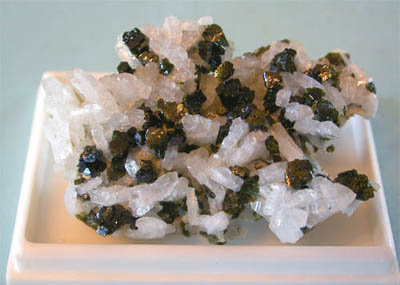
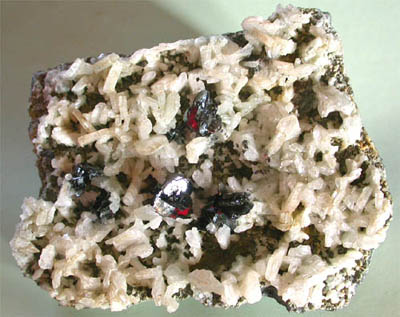
MONTE PENCE
The Monte Pence is located at the confluence of the walloon of Traversagn and of the walloon without name that goes from S.Anna di Bellino to the Colle di Bellino. Both these Walloons are revolts towards south.
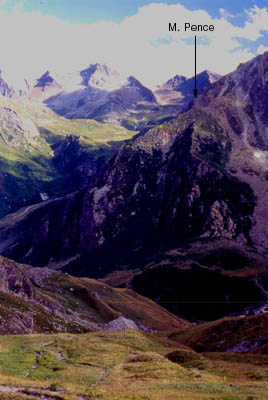
The calcite XXs are also of great collectionistic interest. It is not very common, but it was found in crystals that can reach great dimensions, rather unusual case in the alpine fissures. It is introduced with scalenoedric habit, implanted on albite druses, white color, with surface sometimes corroded from the action of unsafe waters. The sizes of crystals can reach 20 cm.. The more large crystals have been recently recovered in the deepest part of the main system of fissures. The presence of crystals with unusual dimensions increases the interest for this site. The epidote is present in few specimens and didnÂ’t give interesting specimens. It is introduced in thin prismatic crystals with dark green color that very rarely can reach the centimeter of length
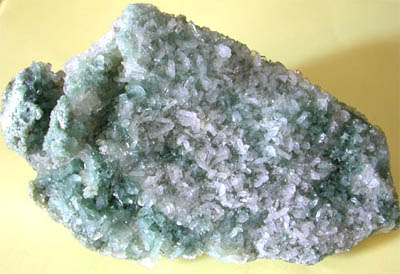
MONTE FERRA
The Monte Ferra (3094 m) is an extended group that constitutes part of the watershed that separates the val Varaita di Chianale from the val Varaita di Bellino. Its depositor delimits the high part of the val Varaita di Rui. From the geologic point of view the M. Ferra is found at the center of a band of ortogneiss and micascists that are extended from the Colle delle Sagneres, on the watershed with it goes to Val Maira, to Colle S.Veran. The micascists constitute the litotype of interest in this formation. In the outcrops that interest this mountain is famous from a long time the presence of the giadeite. It introduces itself in small masses of white color, pseudomorph of potassico feldspar crystals inside the the micascists. The dimensions of these crystals can reach 10 cm. of length and the attribution to the primitive composition before the pseudomorphosis is made on the findings of twined with the CarlsbadÂ’s law. Remarkable interest provokes the presence of the lazulite. The lazulite outcrop interests a most narrow zone of the ridge that joins the Colle di Reisassetto (2743 m) with the Monte Ferra. This species offers in a limited number of specimens an interesting variety of aspects. It is introduced frequently in masses or nodules with intense blue color to the inside of the directly dipped quartz veins embedded in the micascists. Very rarely distinguished crystals were found and they can exceptionally exceed the centimeter of length. To the inside of crystals of greater dimensions zones of transparency of remarkable aesthetic effect are observed sometimes.
MINE OF S.VERAN
The copper’s mine of S.Veran is located in French territory at an altitude comprised between 2400 and 2600 meters at three km. from the border with Italy. It’s easily reachable from Italy thru the Colle S.Veran. The fact that arouses interest is that the mining cultivations of this site are very ancient. In fact from prehistoric reperts recovered within the empties of cultivation and near the mine, it seems that the discovery of the rich copper vein goes back quite to 2000 years before Christ!! In that age, perhaps noticing the vegetation lack due to the toxicity of the too much rich ground of copper, our ancestors discovered that from those cliffs the copper could be gained, one of the first metals used from the man. However tests document them sure of cultivation of the place leave from 1265. For a long period the used technique of digging was the fire and continued in recent ages with the dynamite. The ore body is constituted from one hydrotermal vein of massive bornite with vertical course from north to south. The percentage of copper is of 45%. The maximum thickness is of approximately one meter. The wealth of the ore body is remarkable above all in connection with the ancient techniques of exploitation (little extended but much rich concentrations). It’s remarkable the native copper with dendritics and filaments also of discrete sizes. During the modern works of cultivation in the course of 20° the century, they have been intercepts numerous shafts of prehistoric age with tools of digging in stone. The digging was relatively simple also in ancient age, in how much the embedding cliff the ore body (a cloritoscist) is relatively tender. Also interesting is the fact that many recovered tools are made with eclogite, the hardest cliff that is not present in the surrounding French territory. Vice-versa the eclogite is present in abundance on the Italian side of Alps. This thing take to think that the prehistoric miners came from Italy or attended both the depositors of the Alps.
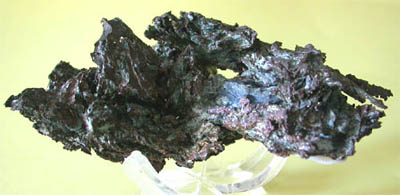
Content by courtesy of :
Information | Mineral photos | VIDEOS | Articles | Fairs | Web directory | Classified ads | Minerals Books | Shop



